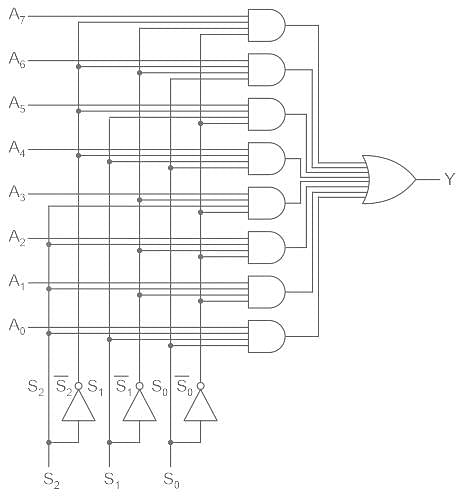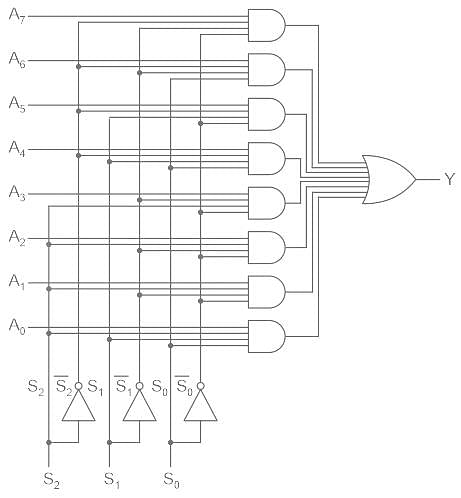Computer Science Engineering (CSE) Exam > Computer Science Engineering (CSE) Questions > How many AND gates are required for a 1-to-8 ...
Start Learning for Free
How many AND gates are required for a 1-to-8 multiplexer?
- a)2
- b)6
- c)5
- d)8
Correct answer is option 'D'. Can you explain this answer?
| FREE This question is part of | Download PDF Attempt this Test |
Most Upvoted Answer
How many AND gates are required for a 1-to-8 multiplexer?a)2b)6c)5d)8C...
Multiplexer:
- It is a combinational circuit that converts multiple inputs into a single output, depending upon the status of the selection lines.
- For n selection lines, 2n inputs are available in a multiplexer.
- Depending upon the status of the selection lines, one input is the selected output of 2n inputs and converted into the output.
Explanation:
- For n selection lines, 2n AND gates are required in a multiplexer.
- For the implementation of 1-to-8 multiplexer, 8 AND gates are required.


Free Test
FREE
| Start Free Test |
Community Answer
How many AND gates are required for a 1-to-8 multiplexer?a)2b)6c)5d)8C...
1-to-8 Multiplexer
A multiplexer is a combinational circuit that selects one of many inputs and directs it to a single output based on the control signals. In a 1-to-8 multiplexer, there are 8 data inputs, one output, and 3 control input lines.
Working of a 1-to-8 Multiplexer
A 1-to-8 multiplexer has 8 data inputs, labeled D0 to D7, and 3 control input lines, labeled A, B, and C. The control input lines determine which data input is selected and passed to the output.
The control input lines can represent 3 binary values: 000, 001, 010, 011, 100, 101, 110, and 111. These binary values can be used to select one of the 8 data inputs.
Implementation of a 1-to-8 Multiplexer using AND gates
To implement a 1-to-8 multiplexer using AND gates, we need to consider the truth table of the multiplexer and derive the logic expressions for the output based on the control input.
The truth table for a 1-to-8 multiplexer is as follows:
| A | B | C | D0 | D1 | D2 | D3 | D4 | D5 | D6 | D7 | Y |
|---|---|---|----|----|----|----|----|----|----|----|---|
| 0 | 0 | 0 | X | X | X | X | X | X | X | X | Y |
| 0 | 0 | 1 | X | X | X | X | X | X | X | X | Y |
| 0 | 1 | 0 | X | X | X | X | X | X | X | X | Y |
| 0 | 1 | 1 | X | X | X | X | X | X | X | X | Y |
| 1 | 0 | 0 | X | X | X | X | X | X | X | X | Y |
| 1 | 0 | 1 | X | X | X | X | X | X | X | X | Y |
| 1 | 1 | 0 | X | X | X | X | X | X | X | X | Y |
| 1 | 1 | 1 | X | X | X | X | X | X | X | X | Y |
From the truth table, we can derive the logic expressions for the output Y as follows:
Y = (A' * B' * C' * D0) + (A' * B' * C * D1) + (A' * B * C' * D2) + (A' * B * C * D3) + (A * B' * C' * D4) + (A * B' * C * D5) +
A multiplexer is a combinational circuit that selects one of many inputs and directs it to a single output based on the control signals. In a 1-to-8 multiplexer, there are 8 data inputs, one output, and 3 control input lines.
Working of a 1-to-8 Multiplexer
A 1-to-8 multiplexer has 8 data inputs, labeled D0 to D7, and 3 control input lines, labeled A, B, and C. The control input lines determine which data input is selected and passed to the output.
The control input lines can represent 3 binary values: 000, 001, 010, 011, 100, 101, 110, and 111. These binary values can be used to select one of the 8 data inputs.
Implementation of a 1-to-8 Multiplexer using AND gates
To implement a 1-to-8 multiplexer using AND gates, we need to consider the truth table of the multiplexer and derive the logic expressions for the output based on the control input.
The truth table for a 1-to-8 multiplexer is as follows:
| A | B | C | D0 | D1 | D2 | D3 | D4 | D5 | D6 | D7 | Y |
|---|---|---|----|----|----|----|----|----|----|----|---|
| 0 | 0 | 0 | X | X | X | X | X | X | X | X | Y |
| 0 | 0 | 1 | X | X | X | X | X | X | X | X | Y |
| 0 | 1 | 0 | X | X | X | X | X | X | X | X | Y |
| 0 | 1 | 1 | X | X | X | X | X | X | X | X | Y |
| 1 | 0 | 0 | X | X | X | X | X | X | X | X | Y |
| 1 | 0 | 1 | X | X | X | X | X | X | X | X | Y |
| 1 | 1 | 0 | X | X | X | X | X | X | X | X | Y |
| 1 | 1 | 1 | X | X | X | X | X | X | X | X | Y |
From the truth table, we can derive the logic expressions for the output Y as follows:
Y = (A' * B' * C' * D0) + (A' * B' * C * D1) + (A' * B * C' * D2) + (A' * B * C * D3) + (A * B' * C' * D4) + (A * B' * C * D5) +
Attention Computer Science Engineering (CSE) Students!
To make sure you are not studying endlessly, EduRev has designed Computer Science Engineering (CSE) study material, with Structured Courses, Videos, & Test Series. Plus get personalized analysis, doubt solving and improvement plans to achieve a great score in Computer Science Engineering (CSE).

|
Explore Courses for Computer Science Engineering (CSE) exam
|

|
Similar Computer Science Engineering (CSE) Doubts
How many AND gates are required for a 1-to-8 multiplexer?a)2b)6c)5d)8Correct answer is option 'D'. Can you explain this answer?
Question Description
How many AND gates are required for a 1-to-8 multiplexer?a)2b)6c)5d)8Correct answer is option 'D'. Can you explain this answer? for Computer Science Engineering (CSE) 2024 is part of Computer Science Engineering (CSE) preparation. The Question and answers have been prepared according to the Computer Science Engineering (CSE) exam syllabus. Information about How many AND gates are required for a 1-to-8 multiplexer?a)2b)6c)5d)8Correct answer is option 'D'. Can you explain this answer? covers all topics & solutions for Computer Science Engineering (CSE) 2024 Exam. Find important definitions, questions, meanings, examples, exercises and tests below for How many AND gates are required for a 1-to-8 multiplexer?a)2b)6c)5d)8Correct answer is option 'D'. Can you explain this answer?.
How many AND gates are required for a 1-to-8 multiplexer?a)2b)6c)5d)8Correct answer is option 'D'. Can you explain this answer? for Computer Science Engineering (CSE) 2024 is part of Computer Science Engineering (CSE) preparation. The Question and answers have been prepared according to the Computer Science Engineering (CSE) exam syllabus. Information about How many AND gates are required for a 1-to-8 multiplexer?a)2b)6c)5d)8Correct answer is option 'D'. Can you explain this answer? covers all topics & solutions for Computer Science Engineering (CSE) 2024 Exam. Find important definitions, questions, meanings, examples, exercises and tests below for How many AND gates are required for a 1-to-8 multiplexer?a)2b)6c)5d)8Correct answer is option 'D'. Can you explain this answer?.
Solutions for How many AND gates are required for a 1-to-8 multiplexer?a)2b)6c)5d)8Correct answer is option 'D'. Can you explain this answer? in English & in Hindi are available as part of our courses for Computer Science Engineering (CSE).
Download more important topics, notes, lectures and mock test series for Computer Science Engineering (CSE) Exam by signing up for free.
Here you can find the meaning of How many AND gates are required for a 1-to-8 multiplexer?a)2b)6c)5d)8Correct answer is option 'D'. Can you explain this answer? defined & explained in the simplest way possible. Besides giving the explanation of
How many AND gates are required for a 1-to-8 multiplexer?a)2b)6c)5d)8Correct answer is option 'D'. Can you explain this answer?, a detailed solution for How many AND gates are required for a 1-to-8 multiplexer?a)2b)6c)5d)8Correct answer is option 'D'. Can you explain this answer? has been provided alongside types of How many AND gates are required for a 1-to-8 multiplexer?a)2b)6c)5d)8Correct answer is option 'D'. Can you explain this answer? theory, EduRev gives you an
ample number of questions to practice How many AND gates are required for a 1-to-8 multiplexer?a)2b)6c)5d)8Correct answer is option 'D'. Can you explain this answer? tests, examples and also practice Computer Science Engineering (CSE) tests.

|
Explore Courses for Computer Science Engineering (CSE) exam
|

|
Suggested Free Tests
Signup for Free!
Signup to see your scores go up within 7 days! Learn & Practice with 1000+ FREE Notes, Videos & Tests.
























